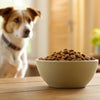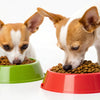Does Dog Kibble Go Stale? Understanding Freshness and Storage for Your Pup's Food
- Houndsy
Table of Contents
- Introduction
- The Shelf Life of Dog Kibble
- Signs That Your Dog's Kibble Has Gone Bad
- Best Practices for Storing Dog Kibble
- The Role of Preservatives in Kibble
- The Impact of Oxidation on Kibble
- Feeding Fresh Kibble: A Responsibility We Share
- Conclusion
Introduction
Imagine coming home after a long day, only to discover that your furry friend is less than excited about their dinner. You pour out the kibble, but something seems off. The smell isn’t as appetizing, and your dog snubs their nose at the bowl. Have you ever wondered why this happens? It might be because your dog’s kibble has gone stale. According to studies, dry dog food can lose its nutritional value and palatability just as easily as human food, yet many pet owners remain unaware of how to store it properly.
In this blog post, we will explore the question, "Does dog kibble go stale?" and provide you with valuable insights on how to keep your dog’s food fresh and nutritious. We will delve into factors that affect kibble freshness, storage tips to maximize shelf life, signs that your dog’s food has gone bad, and the implications of feeding stale kibble to your pet. By the end of this article, you will have a comprehensive understanding of how to maintain the quality of your dog’s food, ensuring that mealtime is a delightful experience for both you and your furry companion.
As we navigate through this topic, we encourage you to reflect on your own pet feeding routines. Are you using the best practices for storing your dog’s kibble? Let’s dive into the details!
The Shelf Life of Dog Kibble
When we talk about how long kibble stays fresh, it’s essential to understand the two primary conditions: unopened and opened. Unopened bags of kibble can last anywhere from 12 to 18 months, depending on the ingredients and manufacturing process. This extended shelf life is largely due to the packaging, which is specifically designed to keep out moisture and air that can cause spoilage.
Once you open the bag, however, the rules change significantly. Generally, opened kibble should be consumed within 6 weeks to ensure it retains its nutritional value and taste. Exposure to air starts a process called oxidation, which can degrade the fats and nutrients in the food, leading to a stale product.
Factors Affecting Freshness
Several factors can impact how long your dog’s kibble will remain fresh:
- Ingredients: The type of fats and preservatives used in kibble can significantly affect its shelf life. For instance, kibble containing fish oil tends to go rancid much faster than those with beef fat due to the instability of polyunsaturated fats.
- Packaging: High-quality packaging helps keep kibble fresh by preventing air and moisture exposure. Always check for a zip seal or an airtight closure to help maintain freshness.
- Storage Conditions: Storing kibble in a cool, dark, and dry location is essential. Heat, light, and humidity can all contribute to spoilage.
- Kibble Size: Smaller bags are often better for pet owners with smaller dogs. This way, the food can be consumed faster, reducing the chance of it going stale before it’s finished.
The Importance of Freshness
Feeding your dog stale kibble can lead to various health issues. Not only does stale kibble have reduced nutritional value, but it can also cause digestive problems or aversion to food—making mealtime a hassle rather than a joy.
Signs That Your Dog's Kibble Has Gone Bad
So how can you tell if your dog’s kibble has lost its freshness? Here are some common signs to watch for:
- Smell: Fresh kibble should have a pleasant, appetizing scent. If it smells rancid or off, it’s time to toss it.
- Texture: Good kibble should have a firm, dry texture. If you notice it’s become moist, crumbly, or has developed clumps, it’s likely gone bad.
- Appearance: Look for any signs of mold or insects. If you see these, do not feed the kibble to your dog.
- Dog's Behavior: If your pup suddenly refuses to eat their food, it could be a sign that the kibble is stale or unappealing.
Best Practices for Storing Dog Kibble
To maintain the freshness and quality of your dog’s kibble, here are some effective storage tips:
Keep It in the Original Packaging
The packaging of dog food is designed to preserve freshness, so it's best to keep the kibble in its original bag. If you need to transfer the kibble to a different container, consider placing the entire bag into an airtight container. This method helps prevent exposure to air and potential contaminants.
Store in a Cool, Dark Place
Heat and light can accelerate the degradation of kibble. Aim to store the food in a pantry or cupboard that remains cool and away from direct sunlight.
Use an Airtight Container
If you prefer to store kibble in a separate container, ensure it's airtight. Many pet owners opt for containers made from food-grade materials to avoid chemical reactions that might occur with ordinary plastics.
Keep the Environment Dry
Moisture is one of the primary culprits of spoilage. Ensure the storage area is dry, and avoid storing kibble in areas prone to humidity, such as basements or garages.
Portion Control
If you have a smaller dog, consider buying smaller bags of kibble rather than large ones. Smaller quantities are more likely to be consumed before going stale, ensuring your pet always enjoys fresh food.
The Role of Preservatives in Kibble
Understanding the role of preservatives in your dog’s kibble can help you make informed choices. Preservatives are added to extend shelf life and maintain freshness, but they vary between natural and synthetic options.
Natural Preservatives
Natural preservatives, such as mixed tocopherols (vitamin E), rosemary extract, and citric acid, are often preferred by health-conscious pet owners. These options tend to be less toxic and may offer additional health benefits to your dog.
Synthetic Preservatives
Synthetic preservatives like BHA, BHT, and ethoxyquin are commonly used in kibble. While they effectively prolong shelf life, some pet owners are wary of their potential health risks. Always review the ingredient list to understand what’s in your dog’s food.
The Impact of Oxidation on Kibble
Oxidation is a natural process that occurs when fats and oils in kibble come into contact with oxygen. This reaction can lead to rancidity, diminishing the food’s nutritional value and taste.
How to Mitigate Oxidation
- Seal the Bag: After opening, always seal the bag tightly to limit air exposure.
- Limit Air Exposure: If using a container, squeeze out as much air as possible before sealing.
- Choose Quality Brands: Opt for kibble brands that prioritize freshness and use high-quality, stable fats.
Feeding Fresh Kibble: A Responsibility We Share
As responsible pet owners, it’s our duty to ensure our furry companions receive the best nutrition possible. By understanding how long kibble lasts and how to store it correctly, we can enhance our dogs’ feeding experience.
At Houndsy, we are dedicated to simplifying and elevating the dog-feeding experience. Our flagship product, the Houndsy Kibble Dispenser, is designed to keep your kibble fresh while providing perfect portion control. With its mid-century modern design, our dispenser not only functions flawlessly but also complements your home decor seamlessly.
Conclusion
In summary, dog kibble can go stale, and it’s crucial to be proactive in maintaining its freshness. By understanding the shelf life of kibble, recognizing the signs of spoilage, and implementing proper storage practices, we can ensure that our dogs enjoy every meal.
Reflect on your current feeding routine—are you storing your dog’s food in a way that preserves its quality? Investing in a product like the Houndsy Kibble Dispenser can make all the difference in keeping kibble fresh and enhancing your daily feeding ritual.
FAQ
1. How long does kibble last once opened?
Opened kibble should ideally be consumed within 6 weeks to maintain its nutritional quality and palatability.
2. Can stale kibble make my dog sick?
While stale kibble may not always cause immediate illness, it can lead to digestive problems over time and lacks essential nutrients.
3. How should I store open dog kibble?
Store opened kibble in an airtight container, in a cool, dark place, and away from moisture to maximize freshness.
4. What are the signs that kibble has gone bad?
Signs include an off smell, a change in texture (moist or crumbly), visible mold or insects, and your dog refusing to eat it.
5. Should I buy kibble in bulk?
Consider purchasing smaller bags if your dog is not likely to finish a large bag within 6 weeks. This reduces the risk of stale food.
By following these insights and tips, we can ensure that our beloved pets enjoy fresh, nutritious meals every day. So, let’s make feeding time a joyful occasion with Houndsy's innovative solutions!












